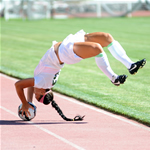2016/7/27 10:04:04

Alex Hansen takes a throw-in early on during an Idaho State women's soccer game. She knows that what she's about to do is going to cause a buzz in the crowd.
So she backs up about 10 feet from the sideline, ball in hand, and gets a running start. After about five steps, she plants the ball in the ground, flings her body over the ball and lands on her two feet just behind the out-of-bounds line. She then uses her core muscles to force her torso back up, and she throws the ball just as the momentum is at its peak. In one violent motion, her acrobatic "flip throw" launches the ball 40 yards toward goal, like a cannon.
Predictably, Hansen's method is met with "ooohs" and "ahhhs" from a crowd not expecting such a scene.
"It's fun," Hansen says. "It's definitely something people get excited about."
The flip throw is a rare weapon in soccer. Mostly, it's a throw used in the attacking third of the field, and is almost exclusively done by soccer players with an extensive gymnastics background, like Hansen.
In short, flip throws entail doing a front handspring with the ball underneath your hands, then launching the ball when enough potential energy is built.
Done right, it can place the ball perfectly within striking range in front of the goal, something most normal throw-ins can't accomplish. Flip throws can be as opportunistic as a corner kick, which is why they're so valuable.
"All of my coaches," said Marquette men's player Michael Alfano, another flip-thrower, "have encouraged me to use it."
Alfano also has an gymnastics background dating back to kindegarten. When a teammate on his U13 team mentioned the possibility of doing a flip throw, he was intrigued.
"So we started practicing it in a gym for a couple of weeks," Alfano said.
After about a month of practice, Alfano tried it in a game. He hasn't looked back.
"I haven't done a normal throw-in in a long time," he admits.
Hansen was a little more cautious. She was about 12 years old when her mother saw someone do a flip throw at a soccer tournament in Salt Lake City. She immediately encouraged Hansen to put her gymnastics background to good use on the soccer pitch.
"I practiced it for a long time, because it took me a long time to land on my feet," Hansen said. "Even the first couple of times I did it in a game, I fell on my butt. That was kind of embarrassing, but every time I did it, I kept getting better and better."
The exact technique to flip throws can vary. Hansen and Alfano both land on two feet like a true front handspring. Others will do flip throws landing one foot at a time, similar to a front handspring step out.
"With two, I have more power," Hansen said.
Once the technique of the throwing is refined, the advanced throwers can take it to another level. At times, Alfano will loft the ball higher in the air if he has a teammate who's tall and can definitely get a head on it. Or, he can choose to throw it as far as he can on more of a line, toward the far post. He estimates he can launch it about 50 yards if he needs to.

Mostly, flip throws are used in the attacking third of the field. A good flip throw will loft the ball right in front of the goal, where a teammate can score with a strong header. The 2011 Florida Class 4A girls state championship was won when a Laurie Laughlin flip throw was headed in by a teammate in overtime.
Alfano has had similar success. He tallied two assists off his flip throw during his junior season at Marquette, including one in the Big East tournament. Alfano has fine-tuned his flip throw to the point where his teammates can know almost precisely where it's going to go.
"You can get pretty accurate," Alfano said. "Eight out of 10 times, I can get it on a head."

Both Alfano and Hansen admit that one thing will put the flip throw on the shelf every time.
Rain.
"When it's wet outside, we do a regular throw-in," Alfano said. "It's easy to flip off the ball and get hurt (when it's wet)."
Added Hansen: "The ball is usually a lot slicker in the rain, and we have a track around the field. Falling would be bad, and it probably wouldn't go as far because it would slip out of your hand."
Flip throws seem to be more common in the women's game, for two reasons:
Overall, though, the flip throw is rare at all levels of soccer. That's why when Alfano or Hansen unleash one for the first time, the crowd is instantly captivated.
The combination of the acrobatics it requires, the opportunity it provides and the flamboyance fans love makes it one of soccer's true treats.
In the game of football, the concept of scoring goals seems to be an important aspect in the g
Fixionline never takes a step behind in the provision of a high-tech football Software
Being one of the most eloquent sites in sports software provision:The desired website Fixionli
Soccer is the most popular sport in the world with a huge list of fan following and stars whic
Contact management E-mail : [email protected]
Copyright © 2005-2016 Outdoor sports All Rights Reserved